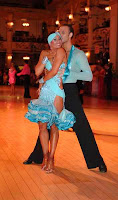"Space Oddity" by David Bowie
In fact, the English requirement is that the man starts on the one (quick) on his right foot, then goes into the rock step, 2, 3 (quick, quick) and the goes into the 4-1 for the slow step. Wrong, wrong, wrong, - but those are their rules. If you are going to compete, you must dance the way they do. Period. Right or wrong.
A little background from Aristides Raul Garcia
(aka Ari, aka Intruso) one of the greats in Latin music and dance knowledge.
 Let's take a closer look at this original dance and the Palladium. (NY) Mike Bello in his "essay": "Mambo, Cuba created it, New York perfected it", takes the Mambo on a non- stop supersonic flight from Cuba to NYC. He, like every other "dance on 2" expert, decides to ignore the fact that the transculturalisation of Afro Cuban music in the Caribbean Basin was in motion long before the Mambo made it to New York.
Let's take a closer look at this original dance and the Palladium. (NY) Mike Bello in his "essay": "Mambo, Cuba created it, New York perfected it", takes the Mambo on a non- stop supersonic flight from Cuba to NYC. He, like every other "dance on 2" expert, decides to ignore the fact that the transculturalisation of Afro Cuban music in the Caribbean Basin was in motion long before the Mambo made it to New York.Lets take a brief look at Mexico in relationship to this transculturalisation. For artists coming from the Spanish Caribbean, long before New York became a center of Latin music, Mexico was the Latin Hollywood. The goal of just about every band, singer, or musician from the area was to perform and be recorded there. In turn, many Mexicans took to this music whole heartedly.
"Cuando Quieres, Dejame" por Pandora
 One of the most famous singers of Sones, Boleros, etc. was the Mexican known as Tona la Negra, whose popularity was superseded, perhaps, only by Celia Cruz. She was, and still is, a legend. Agustin Lara, composer, arranger, and singer (also Mexican) was in high demand all over the Caribbean in the late 40’s and all throughout the 50’s. One of his most famous compositions is "La Clave y el Bongo alegran el Corazon". He was writing poems and music to the Claves before Manhattan knew how to eat with them.
One of the most famous singers of Sones, Boleros, etc. was the Mexican known as Tona la Negra, whose popularity was superseded, perhaps, only by Celia Cruz. She was, and still is, a legend. Agustin Lara, composer, arranger, and singer (also Mexican) was in high demand all over the Caribbean in the late 40’s and all throughout the 50’s. One of his most famous compositions is "La Clave y el Bongo alegran el Corazon". He was writing poems and music to the Claves before Manhattan knew how to eat with them.Before New York knew about the Mambo, Mario Moreno (Cantinflas) - also Mexican, was dancing it both seriously and comically. In reality by the time the Mambo made it to NYC, it was considered "zapato viejo" (old shoe) even in Cuba.
"Cariñito Azucarado" por Angelica Vale
 The Cuban Perez Prado, to whom some people attribute the creation of the Mambo, was well established for years in Mexico before the Mambo arrived in Manhattan. He was the darling of the upper classes, and the chic, not only in Mexico, but all over Latin America. In an interview, Tito Puente told Marla Friedler that he was the first one to put dancers on the stage.
The Cuban Perez Prado, to whom some people attribute the creation of the Mambo, was well established for years in Mexico before the Mambo arrived in Manhattan. He was the darling of the upper classes, and the chic, not only in Mexico, but all over Latin America. In an interview, Tito Puente told Marla Friedler that he was the first one to put dancers on the stage.Perez Prado was doing that in Mexico almost 60 years ago!!!, probably with Mexican dancers. Many Mexicans took to the Son, the Danzon, the Mambo, etc. In fact, even today the Danzon is taught in the Ballrooms of Mexico. The movie simply titled "Danzon" gives a good picture of this phenomena.
"Todo, Todo, Todo" por Daniell Romo
 I mention the Mexican ruling class and the chic, because to talk about Latin Music and Dance without referring to economic classes, demographics, race, age groups, and even political beliefs, is to be myopic. For example, Salsa music owes its origin to two Cuban music and dances: the Danzon which was the music of the rich and powerful, and the working class Son.
I mention the Mexican ruling class and the chic, because to talk about Latin Music and Dance without referring to economic classes, demographics, race, age groups, and even political beliefs, is to be myopic. For example, Salsa music owes its origin to two Cuban music and dances: the Danzon which was the music of the rich and powerful, and the working class Son.The Danzon finds its origin in the French Contre Danse, which derives its name from the English Country Dance, which had become the dance of the French royal court and of the colonialists in Haiti. When the slaves rebelled and threw them out, many of these colonialists moved, not back to France, but to Santiago de Cuba.
(to be continued, our readers may learn a little something just for fun. Chapter two will be in Town Dancer.)

No comments:
Post a Comment